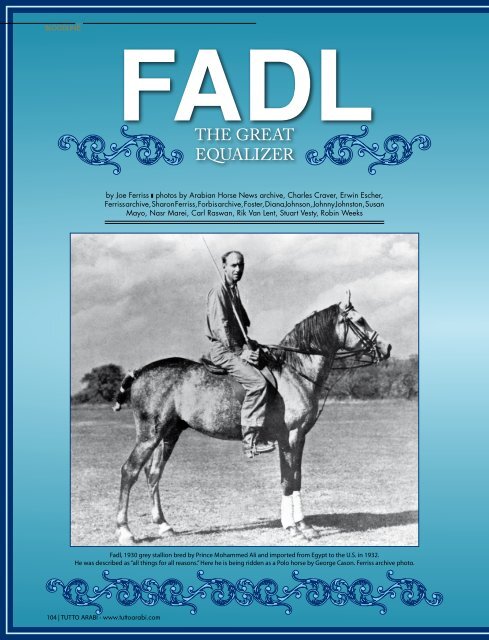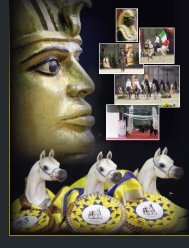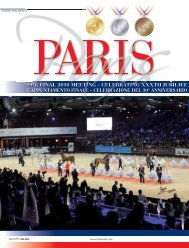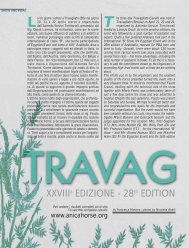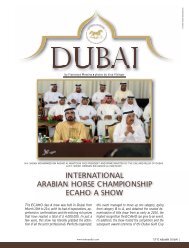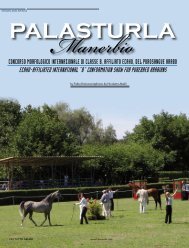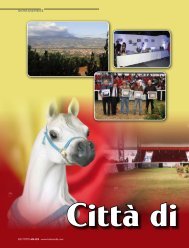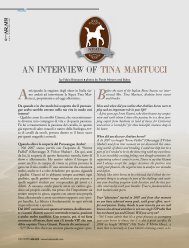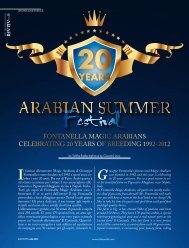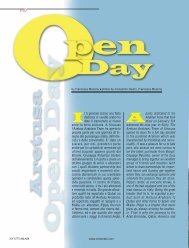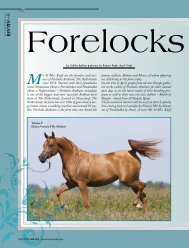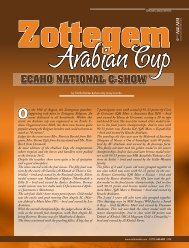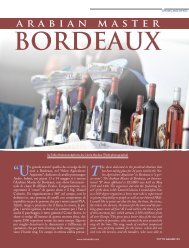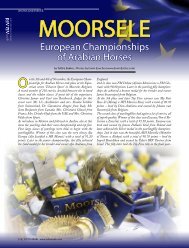Create successful ePaper yourself
Turn your PDF publications into a flip-book with our unique Google optimized e-Paper software.
BLOODLINE<br />
Fadl<br />
The great<br />
equalizer<br />
by Joe Ferriss z photos by Arabian Horse News archive, Charles Craver, Erwin Escher,<br />
Ferriss archive, Sharon Ferriss, Forbis archive, Foster, Diana Johnson, Johnny Johnston, Susan<br />
Mayo, Nasr Marei, Carl Raswan, Rik Van Lent, Stuart Vesty, Robin Weeks<br />
Fadl, 1930 grey stallion bred by Prince Mohammed Ali and imported from Egypt to the U.S. in 1932.<br />
He was described as “all things for all reasons.” Here he is being ridden as a Polo horse by George Cason. Ferriss archive photo.<br />
104 | TUTTO ARABI - www.<strong>tutto</strong><strong>arabi</strong>.com
BLOODLINE<br />
Ibn Rabdan, 1917 dark liver chestnut stallion, the senior sire at the R.A.S. He is the sire of Fadl.<br />
Forbis archive photo.<br />
W<br />
hy would anyone care about an Arabian<br />
stallion born in Egypt 80 years ago? It seems<br />
like such a long time ago. Yet certain Arabian<br />
ancestors become a key ingredient in today’s Arabians over<br />
a longer period of time, more so than many people realize.<br />
So it seems only fitting that we celebrate in this feature, the<br />
Egyptian stallion Fadl.<br />
One cannot fully appreciate this stallion’s contribution<br />
without also taking a brief look at his American importer,<br />
Henry Babson. Mr. Babson grew up in an era when<br />
horses were still embedded in American everyday life. So<br />
their value was first and foremost for their usefulness and<br />
secondly for their appearance. While the Babson family<br />
was entrepreneurial in a variety of interests, their ties<br />
to agriculture were strong. Henry Babson’s exposure to<br />
Arabian type horses was quite by accident while as a young<br />
man participating on a long trail drive of cattle. Each<br />
man was provided seven or eight horses for the cattle drive<br />
but one man showed up with only 4 part Arabians and<br />
Henry was amazed at how they worked the entire drive<br />
finishing in better condition than they started. They were<br />
good looking horses. This made a strong impression on him<br />
and later after years of success in business, Mr. Babson at<br />
age 57 decided to establish a farm to raise Arabian horses.<br />
While he had traveled to a number of foreign countries,<br />
only the horses in Egypt seemed to fit his ideal of the type<br />
of horse he wanted to raise. The result was the now famous<br />
6 Egyptian imports to the U.S. in 1932. He did also later<br />
import some Arabians from Poland and England, though<br />
he is most remembered for his Egyptian bred Arabians.<br />
Of the original Egyptian imports only one of them was a<br />
stallion. His name was Fadl. He was born in 1930 being<br />
bred by Prince Mohammed Ali Tewfik from the Prince’s<br />
famous Bint Yamama line. She was considered the key to<br />
all the real Arabian horse quality in the Prince’s program.<br />
Fadl was sired by Ibn Rabdan, a very dark liver chestnut<br />
Hadban Enzahi stallion used considerably by the Egyptian<br />
Government stud (R.A.S.). The Prince was interested in<br />
breeding to Ibn Rabdan because he tended to sire very dark<br />
colors and the Prince had a desire to produce an Arabian<br />
that was black in color. However, Bint Yamama’s line was<br />
very powerful for her look and as a result the Prince got<br />
grey horses, usually resembling more the dam line. This was<br />
good however because of the inherent beauty and quality<br />
of the Bint Yamama line which had become admired<br />
by foreign visitors. Ibn Rabdan could be counted on for<br />
overall good body quality and conformation but the true<br />
head quality came from Fadl’s dam, the lovely Mahroussa<br />
www.<strong>tutto</strong><strong>arabi</strong>.com - TUTTO ARABI | 105
BLOODLINE<br />
Mahroussa, 1920 grey mare bred by Prince Mohammed Ali.<br />
Shown here being ridden by one of the Prince’s grooms in his gardens at Manial Palace.<br />
She is the dam of Fadl and was a beautiful example of the Prince’s breeding. Forbis archive photo.<br />
a grand daughter of Bint Yamama. In a way Mahroussa<br />
was almost like Bukra at the R.A.S. years later, admired by<br />
visitors for a special kind of beauty that radiated from her.<br />
Fadl was a very handsome grey stallion. He seemed to have<br />
just the right amounts of everything desirable from each<br />
parent. His body was strong and balanced with good neck,<br />
powerfully arched, excellent shoulders, and good depth<br />
of body, excellent legs and strong gaskins. His head was<br />
masculine but very handsome. In the old days of Arabian<br />
breeding stallions were always distinctively masculine and<br />
mares clearly feminine. His eyes were large and well placed<br />
out on the corners of his head. His jaws were round and deep,<br />
his ears were short and shapely, the overall impression was<br />
one like that illustrated in 19th century engravings and<br />
paintings of Arabian horses which no doubt was pleasing<br />
to Mr. Babson. To him it was the ideal, the picture of both<br />
strength and beauty. There was also a little detail about<br />
Fadl’s descendants which was an added touch, they tended<br />
to carry their tails naturally up in a sweeping arch like a<br />
palm branch, even when walking, and this touch gave a<br />
very flowing impression when walking. I experienced this<br />
personally when I saw Fadl’s last living straight Egyptian<br />
son Lothar (x Habba by Fadl) who was 75% Fadl. Lothar<br />
carried his tail in a wonderful arch and when he walked<br />
he looked just like those old engravings, flowing graceful<br />
curves everywhere. Also to Mr. Babson’s liking, Fadl’s<br />
offspring were athletic horses, blessed with great agility and<br />
the most wonderful temperaments. They were intelligent,<br />
easy to train animals. For this reason Fadl was referred to<br />
as the horse who was “all things for all reasons.” He was<br />
used in Polo competitions, he was used in harness, he was a<br />
trustworthy pleasure mount for the Babson family and he<br />
was even used as an Arab sire in the improvement of some<br />
local draft stock. But most of all, he was Mr. Babson’s ideal<br />
image of that “old world” type of Arabian as depicted in<br />
19th century art.<br />
In Fadl’s lifetime in America there were scarcely any other<br />
Egyptian mares outside of Mr. Babson’s own importation.<br />
Nonetheless Fadl sired 74 get in America, a considerable<br />
number for his era from a private farm that did not<br />
generally stand its stallions to outside mares. Of Fadl’s get,<br />
34 were from the Babson Egyptian mares. The other 40<br />
were from mainly additional Babson imports from other<br />
countries and a few private breedings from American<br />
breeders acquainted with Mr. Babson.<br />
Among the non-Egyptian imports by Mr. Babson was the<br />
lovely Saudi desert bred mare Turfa, bred by the Saud Royal<br />
family, who crossed very well with Fadl, a very impressive<br />
cross which remains popular today among devotees of the<br />
106 | TUTTO ARABI - www.<strong>tutto</strong><strong>arabi</strong>.com
BLOODLINE<br />
desert Arabian. A number of U.S. National Performance<br />
winners trace to the Fadl x Turfa cross since she was also a<br />
superior moving horse and, like Fadl, was known for her<br />
wonderful temperament.<br />
Mr. Babson also imported several mares from Poland that<br />
included Azja IV, Kostrewza, Rybitwa and Kasztelanka.<br />
These were of the old pre-war Polish lines and his<br />
importation took place just before the invasion of Poland.<br />
These mares were bred to Fadl and eventually became<br />
broodmares for other farms when Babson returned to his<br />
Egyptian-bred focus. However, one particular mating<br />
from this group would turn out to be a breeding that<br />
spread Fadl’s blood worldwide. The excellent Polish import<br />
Kasztelanka was bred to Fadl producing the handsome<br />
and noble stallion Fadheilan. Fadheilan in turn sired the<br />
legendary and charismatic stallion Fadjur who for many<br />
years was the all time leading sire of Arabians in America<br />
with 839 get. In turn Fadjur was bred to his half sister<br />
Fadneeka, producing the beautiful multi-champion mare<br />
Jurneeka, a double Fadl mare. It must be remembered that<br />
a great mare spreads her influence farther if an excellent<br />
son of hers is heavily used. Jurneeka in turn produced the<br />
beloved stallion Khemosabi, who even now 12 years since<br />
his last foal was born (before widespread use of frozen<br />
semen), is the world’s leading sire of Arabian horses with<br />
1264 get. Not even taking into account Fadl’s role in<br />
straight Egyptian breeding, just through the widespread<br />
use of Fadjur and his grandson Khemosabi, Fadl appears in<br />
tens of thousands of Arabian pedigrees around the world.<br />
Fadl’s role within straight Egyptian breeding is also<br />
much more pervasive than people realize. He was the only<br />
straight Egyptian stallion in the original group of imports<br />
so he appears multiple times within the Babson Egyptian<br />
program. One of the imported mares, Maaroufa, was also<br />
his full sister, so between Fadl and his sister their ancestry<br />
was a significant factor. Yet over the years an interesting<br />
generality developed in the kinds of Egyptian horses bred<br />
at Babson’s. Each of the imported mares had their own<br />
strong influence which emerged over time, so there was<br />
considerable diversity of type in Babson Egyptians, not all<br />
of them looking like Fadl or Maaroufa. When grey horses<br />
were produced they seemed to resemble more the type of horses<br />
bred by Prince Mohammed Ali, like Fadl and Maaroufa,<br />
and one can see the look of Fadl’s dam Mahroussa in some<br />
of his descendants. When black or dark bay horses were<br />
produced they sometimes seemed to show the influence of<br />
Fadl’s sire Ibn Rabdan or Bint Serra’s sire Sotamm, or<br />
Bint Bint Sabbah’s grandsire Kazmeyn, with pleasant but<br />
not beautiful heads. When chestnuts were produced they<br />
were sometimes reminiscent of Ibn Rabdan’s influence and<br />
sometimes a bit more refined like Bint Saada. The mares<br />
Bint Serra and Bint Saada tended to add height, more<br />
Fadl being ridden at the Babson farm by Mr. Babson’s grand daughter. Ferriss archive photo.<br />
www.<strong>tutto</strong><strong>arabi</strong>.com - TUTTO ARABI | 107
BLOODLINE<br />
Fadl overlooking the Babson farm<br />
in old age. Note the dramatically<br />
curved neck, large prominent eyes,<br />
deep jowls and beautifully shaped<br />
ears - the “old world” look of 19th<br />
century artists.<br />
Charles Craver photo.<br />
Fadjur<br />
(Fadheilan by Fadl x Bint Sahara)<br />
1952 bay stallion. A very charismatic<br />
stallion and great sire, Fadjur was the<br />
dream horse in America and for many<br />
years the leading sire of Arabians.<br />
Arabian Horse News<br />
archive photo 1958.<br />
withers and longer forearms if line-bred. The grey stallion<br />
Ibn Fa-Serr (Fa-Serr x Fa Deene) a Saqlawi inbred<br />
to Bint Serra, was a sire of superior movement, giving<br />
powerful shoulders and higher neck set. His greys tended to<br />
show more refinement in the head, like his dam Fa Deene<br />
while some of his blacks were more masculine like his sire,<br />
Fa-Serr. Generally Ibn Fa-Serr added a bit more height,<br />
but in the long run, Fadl seemed to be the great equalizer,<br />
maintaining an overall balanced body, with graceful<br />
curvy lines, great athletic ability, charismatic, intelligent<br />
personalities and superb dispositions.<br />
In straight Babson Egyptian breeding, Fadl was already<br />
a natural ingredient for blending with later E.A.O. bred<br />
Egyptians. It is interesting to point out his relationship to<br />
other famous Egyptian ancestors. Because Fadl was a son<br />
of Ibn Rabdan and out of a daughter of Mabrouk Manial,<br />
he was already a three quarter brother to both Hamdan<br />
108 | TUTTO ARABI - www.<strong>tutto</strong><strong>arabi</strong>.com
BLOODLINE<br />
Khemosabi (Amerigo x Jurneeka)<br />
still the leading sire world-wide<br />
in terms of number of foals.<br />
He is double Fadl.<br />
Johnny Johnston photo.<br />
Fay El Dine (Fadl x Bint Serra)<br />
1934 grey stallion,<br />
Fadl’s first born Egyptian son,<br />
and a great broodmare sire.<br />
Ferriss archive photo.<br />
www.<strong>tutto</strong><strong>arabi</strong>.com - TUTTO ARABI | 109
BLOODLINE<br />
Fa-Serr (Fadl x Bint Serra)<br />
1947 black stallion, the full brother to<br />
Fay El Dine and the most heavily used<br />
of Fadl’s sons at the Babson Farm.<br />
Ferriss archive photo.<br />
Faddan (Fadl x Bint Saada)<br />
1935 chestnut stallion, the only source<br />
of Bint Saada’s blood. He was closely<br />
related to Moniet El Nefous.<br />
Ferriss archive photo.<br />
(the sire of Anter) and Shahloul who sired the great mares<br />
Moniet El Nefous and Bukra. Mr. Babson’s imported<br />
mare Bint Saada was closely related to Moniet El Nefous’s<br />
grandmother, so when Babson bred Fadl to Bint Saada, he<br />
came close to replicating the pedigree of Moniet El Nefous.<br />
Take for example the superior sire Prince Fa Moniet (2<br />
crosses to Fadl). He is the result of intense line breeding to<br />
Moniet El Nefous on the upper part of his pedigree while<br />
his female line goes to the Faddan (Fadl x Bint Saada)<br />
daughter Fada from the female line of Maaroufa, Fadl’s<br />
full sister. All ingredients here are related in a way that<br />
reinforces Prince Fa Moniet as a dominant sire. When<br />
110 | TUTTO ARABI - www.<strong>tutto</strong><strong>arabi</strong>.com
BLOODLINE<br />
Khebir (Fadl x Bint Bint Sabbah) 1942<br />
chestnut stallion, a popular sire on the<br />
west coast.<br />
Foster photo.<br />
Fa Deene (Fadl x Bint Serra)<br />
1937 grey mare. A lovely mare who is<br />
the dam of Babson sires Ibn Fa-Serr<br />
and Hadbah and also the female line<br />
of the excellent sires AK El Sennari<br />
and Fa Daalim.<br />
Ferriss archive photo.<br />
Fadl was bred to Mr. Babson’s imported mare Bint Bint<br />
Sabah (out of the same mare that produced Bukra), he<br />
came close to replicating the pedigree of Bukra. In fact<br />
63% of this cross was identical to the pedigree of Bukra. In<br />
turn the Fadl x Bint Bint Sabbah cross is the basis for the<br />
famed Ansata Nile family. It all makes sense then when<br />
one realizes the great success of Prince Fa Moniet crossed on<br />
both horses of the Bukra and of the Nile families, producing<br />
such magnificent examples as legendary Ansata Sinan<br />
(Prince Fa Moniet x Ansata Nefara) and Ansata White<br />
Nile, dam of Ansata Nile Echo. Just these few examples<br />
serve to show why the Babson breeding adding Fadl is a<br />
www.<strong>tutto</strong><strong>arabi</strong>.com - TUTTO ARABI | 111
BLOODLINE<br />
Ibn Fa-Serr (Fa-Serr x Fa-Deene) 1960 grey stallion pictured here in old age.<br />
A sire of National winners and a sire of excellent movement. Sharon Ferriss photo.<br />
very compatible choice for many later E.A.O. bred horses.<br />
The Fadl x Bint Bint Sabbah cross has been a key<br />
contributor to many excellent Arabian horses worldwide.<br />
The previously mentioned renowned Nile family from Fa-<br />
Habba (Fadl x Bint Bint Sabbah) is one of those. Another<br />
is the exceptional sire Fabah (Fadl x Bint Bint Sabbah).<br />
He sired British National Champion The Shah (x Bint<br />
Fada) also a sire of champions. Fabah’s son Hadbah (x Fa<br />
Deene) is found in numerous Egyptian champions such as<br />
Paris World Champion, Royal Colours. Fabah sired the<br />
exceptional producing Babson mare Sabrah (x Serrasab),<br />
dam of two famous sisters by Ansata Ibn Halima, Ansata<br />
Sabiha, a celebrated female line in the Middle East, and Fa<br />
Halima U.S. National Champion and Paris Reserve World<br />
Champion. Fabah’s full brother Fasaab sired the stunningly<br />
beautiful producing mare, Maar Ree (x Maarou), founder<br />
of a beautiful and prized line of Egyptians as well as being<br />
the grand dam of the leading Egyptian dam of champions,<br />
RDM Maar Hala (El Hilal x Maar Jumana).<br />
Many who knew her said that the grey mare Habba (Fadl<br />
x Bint Bint Sabbah) was the most beautiful of Bint Bint<br />
Sabbah’s daughters. Judging from the look and legacy of<br />
her progeny, this is certainly believable. Her son Lothar,<br />
the last-born straight Egyptian son of Fadl, was a classic<br />
and typy horse. He was chestnut-roan in color and in the<br />
summer he shimmered like an unusual gem. He was very<br />
charismatic and stylish, dancing with arched neck and<br />
tail held out like a palm branch. I can’t help but think this<br />
must have been the same kind of presence that made the<br />
“Fabulous Fadjur” so popular in his day. In his younger<br />
years he competed in endurance and only saw an Egyptian<br />
breeding opportunity later but his is found in both Babson<br />
and other Egyptian lines.<br />
Habba’s daughter Sirhabba (x Sirecho) was a beautiful<br />
chestnut mare who founded fame for her sons Al Karim<br />
Sirhalima (x Ansata Ibn Halima) and Char Echo (x<br />
Negem). Al Karim Sirhalima became one of the most<br />
112 | TUTTO ARABI - www.<strong>tutto</strong><strong>arabi</strong>.com
BLOODLINE<br />
Ansata Sinan<br />
(Prince Fa Moniet x Ansata Nefara)<br />
1992 grey stallion, a legendary sire<br />
whose blood is highly sought after. A<br />
fine example of the blending of Faddan<br />
(Fadl x Bint Saada) with Moniet and<br />
Bukra blood.<br />
Erwin Escher photo.<br />
Ansata Blue Nile<br />
(Prince Fa Moniet x Ansata Stari Nile)<br />
1990 grey mare. An exquisite example<br />
of the Nile family, blending of Fadl<br />
with Moniet and Bukra.<br />
Rik Van Lent photo.<br />
www.<strong>tutto</strong><strong>arabi</strong>.com - TUTTO ARABI | 113
BLOODLINE<br />
Atiq Haleeb (Laheeb x Hila B) grey stallion bred<br />
by Idan Atiq Egyptian Stud in Israel.<br />
A Supreme National Champion of Namibia and<br />
Supreme West Cape Champion at Worcester,<br />
South Africa. He traces to Fadl through<br />
both Fa-Habba of the Nile family and Habba,<br />
the dam line of Laheeb.<br />
Stuart Vesty photo courtesy of Tzviah Idan.<br />
Fabah (Fadl x Bint Bint Sabbah)<br />
1950 bay stallion pictured here in old<br />
age at the Babson farm.<br />
An excellent sire found internationally<br />
in champions.<br />
Ferriss archive photo.<br />
popular Egyptian sires in Australia with many champions<br />
to his credit. Char Echo was a sire of U.S. National<br />
winners and also of South African National Champion<br />
Anchor Hill Omar. Char Echo had that same kind of<br />
charisma and presence as Fadjur and Lothar. Habba also<br />
produced Sirhabba’s full sister, the high quality grey mare<br />
Asal Sirabba who is famous for one of the most successful<br />
female lines via her granddaughter, AK Latifa, dam of<br />
the celebrated international champion sire Laheeb, and<br />
grand dam of unforgettable Paris World Champion mare<br />
Loubna.<br />
In retrospect, Fadl became “all things to many” given his<br />
pervasive influence in Arabian breeding today throughout<br />
the world. Famous stallions such as Ali Jamaal, Versace,<br />
Afire Bey V and Stival carry crosses to Fadl. Even modern<br />
legend Marwan Al Shaqab traces to Fadl twice through<br />
the Babson Egyptian stallion Sabdaan (Faddan x Fay<br />
114 | TUTTO ARABI - www.<strong>tutto</strong><strong>arabi</strong>.com
BLOODLINE<br />
Fa Halima<br />
(Ansata Ibn Halima x Sabrah by<br />
Fabah), 1970 grey mare, the full sister<br />
to Ansata Sabiha.<br />
Fa Halima was U.S. National<br />
Champion and Paris Reserve World<br />
Champion as an aged mare. Johnny<br />
Johnston photo.<br />
Maar-Ree (Fasaab x Maarou) 1957 grey mare. She founded a dynasty in Egyptian breeding with many beautiful descendants.<br />
She is grand dam of RDM Maar Hala, all time Egyptian dam of champions. Johnny Johnston photo.<br />
www.<strong>tutto</strong><strong>arabi</strong>.com - TUTTO ARABI | 115
BLOODLINE<br />
Lothar (Fadl x Habba by Fadl)<br />
1955 chestnut roan stallion, a classic<br />
and charismatic representative<br />
of Fadl.<br />
Susan Mayo photo.<br />
Laheeb (Imperial Imdal x AK Latifa)<br />
1996 grey stallion, a world famous sire whose<br />
get include Al Lahab. Laheeb is tail female to<br />
the exquisite Habba (Fadl x Bint Bint Sabbah).<br />
Nasr Marei photo courtesy of Tzviah Idan.<br />
116 | TUTTO ARABI - www.<strong>tutto</strong><strong>arabi</strong>.com
BLOODLINE<br />
Mah Deluque (Mahrouf x Bah Habba)<br />
with Babson farm manager John<br />
Vogel. The handsome Mah Deluque<br />
was one of the last senior stallions<br />
at the Babson farm after nearly seven<br />
decades of breeding.<br />
Diana Johnson photo.<br />
Sabbah). Horses associated with Fadl’s influence number<br />
in the many tens of thousands. They have been classic,<br />
charismatic Arabian horses with that special “old world”<br />
look depicted by 19th century artists, and most importantly<br />
fine athletes, contributing to the true versatility of the<br />
Arabian horse well into the future. We are indeed fortunate<br />
that Mr. Babson began his new adventure in 1932 that<br />
has continued to this day. q<br />
An interesting comparison: Mahroussa,<br />
dam of Fadl on the left, and Matara Sireffa born<br />
71 years later with 20 crosses to Fadl.<br />
One can still see the look of Fadl’s dam.<br />
Left is Carl Raswan photo, right is Robin Weeks<br />
photo.<br />
www.<strong>tutto</strong><strong>arabi</strong>.com - TUTTO ARABI | 117


